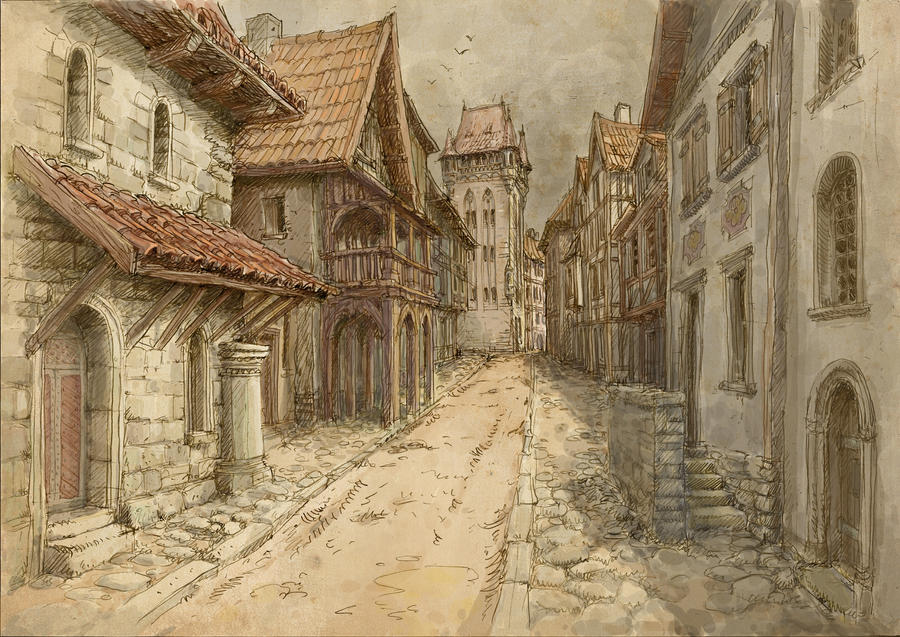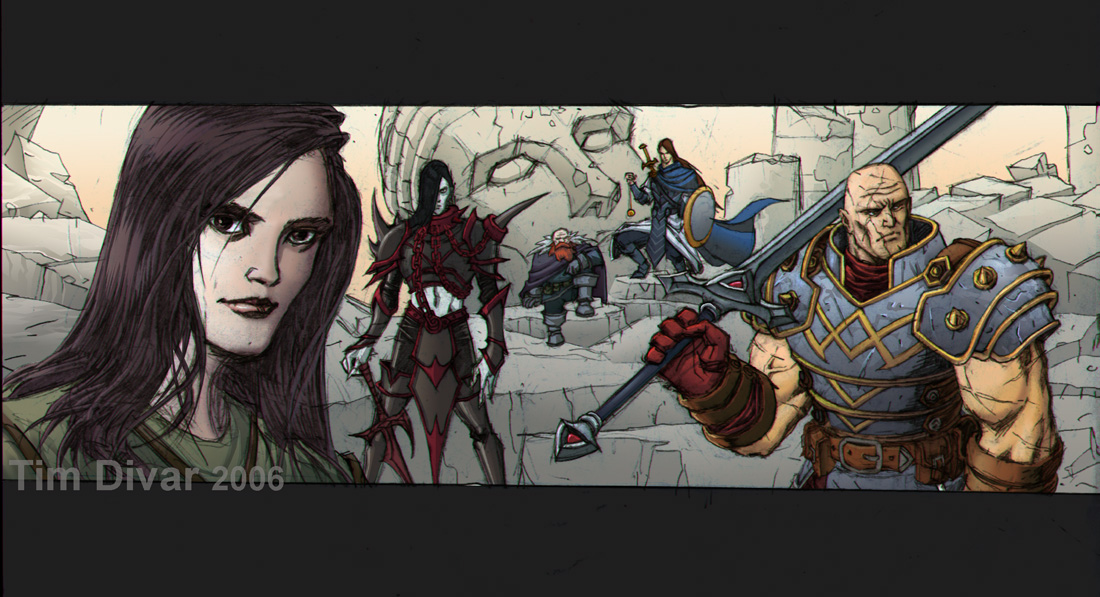Introduction
So, you’’ve got your group of friends gathered, you’’ve got the books, dice and paraphernalia gathered, and you’’’re set to start playing, but someone’’’s got to master the game, and you’’’ve been given the honour of having the group entitling you Dungeon Master. Congratulations! Now what do you do?
Comment: For sake of ease, I will throughout this article use the term “dungeon master”, as I’’m a Dungeons & Dragons-player and have been for years. Read this synonymously with all other titles used, such as game master, storyteller, rolemaster et cetera.
The Planning Step
The more experienced you are, the less planning you’’’ll probably feel the need to do. When running your first adventure, it is always a good idea to start by deciding what your setting is going to be. Do you want your players to play an urban, rural or wilderness adventure? Should it be focused on the roleplaying bit, or should they explore the lands (over and/or below ground); should they be investigators or mercenaries; is the world high or low tech and high or low magic; do the characters know each other, some of each other or none of each other? All these are important questions you need to find the answer to. Let’’’s start by exploring them one by one:
Urban, Rural or Wilderness

In my experience, it is easiest to start playing by creating a small village in which the players have arrived (for their own reasons); this holds both if one is inexperienced as a Dungeon Master and also if much or all of the group are new players. It is easier for them to keep track of everything when there aren’’’t so many things to keep track of, and it is also nice to have a small place to come back to when need be. How rural or urban you choose this place to be, is entirely up to you, but if it is highly urbanised, there should clearly be a good reason for this, as this during the middle ages was more the exception than the rule.
There are several ways to go about to create a village. You can just wing it, note down the more important places and their keepers, such as a tavern, a couple of pubs, a tailor and mercer (seller or textiles), a smith or two, a scabbardmaker, a couple of butchers, a barber, a maidservant, a jeweller, a masoner, a church or small temple and so on. Remember that any village that got the status of being a borough, would have a market, and most towns would as well. A borough would usually see the beginnings of what in the late middle ages would be strong, thick city walls, and would often be more highly militarised; these are important aspects to consider as well.
After having considered the main functions of the town and its population, take some time to consider how the town is placed in the terrain, the main layout of it (a road would most commonly go straight through it, and the town should have easy access to clean water, so a river is most likely nearby, if not running through it), and even more important for the players: who the main non-player characters (NPCs) are. These are the ones the players are going to interact with during their sessions, so figure out what their functions are, professions, gender (if female and running a business: highly likely to be a widow) and race (both colour-wise and fantasy-race-wise). Jot down some quick reference information about them as well, such as whether they’re married (if thirty plus (for a human) and unmarried, are there any particular reasons for this?) (in mediaeval Europe, if living with someone in a marriage-like facility, the church would consider the couple married even if they had not had any formal marriage—confer Michael Sheehan’s collected articles (Sheehan CSB, Michael M. & Farge, James K. (ed.) & Rosenthal, Joel T.: Marriage, Family, and Law in Medieval Europe: Collected Studies. University of Toronto Press, Toronto, Buffalo, 1996.) for more on this subject), have children, are of good health, what their name is and perhaps their associates. If they specialise in any particular items, note these down. Well-planned NPCs are easier for you as the DM to play, and for the players to relate to. Also, if the you find the players connecting to them, the NPCs can be more easily (ab)used by you later, to get the players interested in what’’’s going on.
If you can read Norwegian (or trust Google Translate), I highly recommend reading my posts on my village Fellstad’’’s demography, split into three large posts. The first one concerns itself with which PC- and NPC-classes the town has, who controls it, their basic thoughts of law and order on how much ready cash they have; the second post deals with which professions the ordinary citizens have; and in the third and final one, I deal with how much land it covers (and requires), its livestock, agriculture, as well as people’s’’ names. In all these posts I make an attempt at explaining the method used.
Roleplaying or Exploration?
The DM provides the adventure, and it’’’s his responsibility to guide the players through the evening so all can have fun. (This does not mean the players don’’’t have a responsibility as well, but without the DM, how would the adventure fare?) I, myself, am a keen fan of good roleplaying, and try to liven up my NPCs (this includes intelligent monsters) by acting out a bit. But this is not what this question is concerned with. What you need to decide, is whether you’’’re going to run an adventure based on killing monsters, exploration and investigation or pure role playing. Let’’’s take a look at these three options one at a time.
Pure Monster-Bashing

Some players just love this. In this the purpose of interaction with the friendly NPCs are purely to find out where problems are, so the players can get out there and start the killing. A monster equals treasure and experience points, and this is what drives your players to return to the game table.
When running this sort of campaign, read the chapters on combat very thoroughly, making sure you have a good understanding of how combat works. Have good systems at hand for counting rounds, roll monster initiatives ahead of combat so everything’’’s ready when combat starts, and it might also be a good idea to make some notes on monster tactics during combat, as well as how they respond to being outnumbered, being outnumbering, being low on health and such. Make sure you differentiate intelligent, half-intelligent and non-intelligent monsters; there are important differences in how a band of kobolds, a pack of wolves and a swarm of spiders respond to the players breaching their territory.
Awarding XP and treasure is simple: just follow the guidelines in your books, and it should all be noted there. In Dungeons & Dragons, 1 experience point equals 1 gold piece, and by following the random generation tables as well as awarding XP according to the monsters’ challenge rating, takes care of this by it self. Be adviced though, that if running a low- or no-treasure setting (such as fighting undeads or vermin), you should place some extra treasure here and there to balance it out. Players high on XP and low on cash are going to have a hard time surviving.
Pure Roleplaying

In these kinds of campaigns, what drives the adventures, is the players discovering how information is connected, how the non-player characters change over time and painting the canvas of the story to create the picture of your tale. More important than anything else, is both encouraging the players to act their part, as well as you, the DM to believably give life to the different persons they meet.
Many recommend drawing flow charts to see how pieces of information is connected. Also, the drawing of them might lead you as the dungeon master to realise new ways for the villains to scheme against the players, so give it a go. Good notes are of high importance here; these safeguard you from mixing things up. However, if you do (all dungeon masters do from time to time), the players don’’’t need to know that it was an error on your behalf: Just work it into the adventure; maybe a character lied to them to mislead them, or had been threatened to do so, or maybe the character just didn’’’t remember correctly. This gives the players a reason to return to him or her, and it gives you, the leader of the group, a chance to willingly lead your players astray, and maybe give them a go at monster-whacking for a change of pace.
When awarding players, you should try and use both story-advancement experience points, as well as experience points based on overcoming challenges, such as extracting information from an opponent. To use an example from Dungeons & Dragons: Say the level three party needed the vital clue of information from a fifth level aristocrat. He sends them on a boring errand (which could be a short adventure in and of itself). When they finally retreat, he’’’s still a hard nut to crack. After some good roleplaying, some nice rolls of the dice, perhaps scoring a beautiful 25 on diplomacy, and then further encouraging him to comply by having the bard charm him, the aristocrat finally gives in and tells the players what they need. Even though no-one was killed, it was a challenge overcome, and it should be awarded thusly. The four level three characters defeated a challenge rating five opponent and are according to the experience points tables awarded 450 experience points (a total of 1800 XP.
The Dungeon Master should keep the above information ad notam, and make sure he has extra treasure worth 1800 gold pieces spread around.
A Bit of Both: Exploration

This is the kind of game I play, in which a combination of both the pure roleplaying as well as the evenings of pure monster bashing is sought. The main challenge in this type of campaign is to find the correct balance in awarding the players.
My approach is splitting the adventure into two or three main parts and set an amount of XP that the adventure is worth. I’’’ll cite my own blogpost, D&D: Rollespill-XP – hvordan og hvorfor (D&D: Role Playing XP—How and Why) to explain my thoughts on this:
(……) [Story-XP] can be smart to give when wanting to award the players for making progress in the adventure. Now, I’’’m not thinking of ““’Tonight you were able to smash your way half way through the cavern, so here’ are 1,000 XP for you.”’” I’’’m rather thinking of the situations in which the players finally are able to collect all the loose ends and figure out where to launch their attack. An important step has then been taken in finding the answers to their questions and thus progress in the adventure; at that point it could be appropriate to award them for this.
I suggest keeping this to roughly 10% of what the average level of the group needs in XP to advance to the next level, and to divide this amongst the players (a group with an average level of 5 (which requires 15,000 XP to advance to the next), may then receive 1,500 XP; if the group is made up of four players, that’s 375 XP extra for each of them.)
Perhaps best of all, is to take this amount of XP (in this case 1500), and split it to key points in the story. When they have gathered the necessary loose ends to figure out how to solve the situation, give one third of the XP (…), and when they have succeeded in solving the entire problem (…) [that is: finished the entire adventure], the players receive the remaining experience points.
High or Low Tech/Magic

Eberron is a good example of a world fusing magic and science into a clock-punk setting. Forgotten Realms focused more on magic, and was clearly a high magic setting. Others again, prefer playing a setting where both technology is at a low stage, and magic is hard to come by.
When choosing how technologically advanced your world is, other aspects need to come to mind as well. Historically, the setting people are used to playing in, is actually more of a renaissance world than a high mediaeval ages world. There’’’s nothing wrong with this, but it helps in the believability of the setting that the dungeon master doesn’’t mix up too many periods of time. The level of mundane technology also reflects how economically strong the civilised lands are, as this tends to go hand in hand: a technologically advanced people has a higher need for markets and coinage, as more people are not making their food themselves. Also, technology is usually used either as labour saving devices, or as tools for enforcing power. The wind mills are an interesting example of this (for more on this, read Holt, Richard: The Mills of Medieval England, Basil Blackwell Ltd., Oxford, 1988): one would think their purpose was to save labour for other things, but their main role might just as well have been to secure the peasants’’’ dependency on their master.
When magic is concerned, this could change many factors of society. Is magic easily available? Is low-level magic cheap enough for normal people to invest in it, such as buying a torch embedded with everlasting flame? Or is magic something only the wealthiest have access to? If so, do they use this to show their power, buy doing things for the people? Having gates automatically blocking evil people from entering, or people of the wrong faith from entering (perhaps unless paying a toll) could help protect the people, encourage trade and at the same time show to the people that they should love their benevolent leader and master. Perhaps when going to pubs, shields are permanently cast to prevent mind reading, or one could find signs stating ““No spellcasting”” or ““Spellcasters not allowed””.
Starting the Game and Getting the Characters together

What I’’ve talked about thus far, might seem daunting. My main goal was to get you, the budding dungeon master, some thoughts and ideas, and to cover the most important topics you need to consider before starting your game. The most important thing is to think it through thoroughly; this gets you far.
So now you’’’re supposed to sit down with your players for the first time, and get the games started. You should, before you meet, have told your players how you would like their relations to each other to be. Some of them might prefer being already known to each other beforehand, but this is entirely up to you whether you would allow. What you need to give the players, is a hook allowing them to meet each other. The town might have a militia, but these are highly unlikely to have the time to go out of town to face problems with robbers or such. The players’’ characters have skills few others have, and they should be willing to put these to use. If they have created a character that just wants to settle down and make furniture for a living, they have not made a player character! So make sure your players understand their role in the world, and that they create a character thereafter.
A natural place for people to go when coming to a new town, was of course the public house. Here you could catch up on the latest gossip, and relax while having a pint. For the players to seek out the local pub, tavern or inn is only natural, and feel free to encourage this. Perhaps a couple of the players would like to roam around town and see if they can find some information first about what’’’s happening; this could either be roleplayed or merely done by dice (in Dungeons & Dragons: a Gather information-roll). When they do hear rumours that interest them: if they want to make a living, they’’’ll have to volunteer, and when the first couple of them have, they’’’d might realise they need more people, and try to figure out who else in the public house might be potential candidates. This is your chance to legitimately railroad the players to finding each other. And hey, presto!, you’’’ve got a group.
Make sure you control the flow of action when getting the group started, and don’’’t let the getting-together-bit take to much time. Allow the players to describe themselves, and encourage them to try to stay in character as much as possible; the best way to do this, is by doing this yourself when acting out the NPCs.
One of the worst experiences I’’’ve had as a player, was when playing with a dungeon master who started the game by telling a one-hour long story. Most of the game was played by this DM telling what happened, and we, the players, waiting for a chance to interact with the world. The most important thing you, as the dungeon master, can do, is to trust your players to eagerly grab the bones you toss them. Don’’’t over-plan! Cover the details that allow you to easily give the players information when they reach for it, and then guide them further through your story.
Best of luck, and remember the most important part of roleplaying games: have fun!
Mr. K.
No comments:
Post a Comment